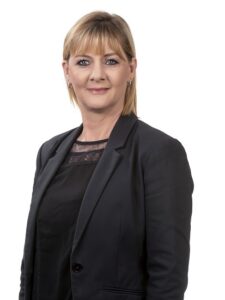Mandy Barrett of Aon South Africa
South Africa is no stranger to the devastating losses of weather catastrophes. In the last few years, heavy rainfalls, flooding and wildfires have increased in frequency and intensity.

Following the KZN flood disaster of April 2022, which the province is still struggling to recover from, the provinces of Free-State, Eastern Cape, Limpopo and Mpumalanga have been battered by severe rainfall and floods during February, with people evacuated from low lying and high-risk areas. At the same time, firefighters in the Western Cape are once again battling runaway fires as temperatures soar and winds bedevil efforts to contain the spread.
In Aon’s latest 2023 Weather, Climate and Catastrophe Insight report, flooding was identified as the second largest peril across the globe and the most prevalent peril on the African Continent, with a devastating economic loss of $66bn (R1,185bn). While the KZN floods of April 2022 were noted as the largest flooding event on the continent with an economic loss of $3.6bn (R64,672bn), what is more concerning is the fact that only 18% of losses were insured.
According to Aon, underinsurance remains a key concern in the face of climate risks, especially when it comes to outright and severe losses which typically follow weather catastrophes like floods and fire. This trend is likely to come under increasing strain in a tough economic environment where costs are under scrutiny. The impact of an outright uninsured or even underinsured loss of a home and other assets can have severe financial and personal consequences.
Underinsurance and your personal assets
The trend of properties and assets being underinsured for their replacement costs was starkly highlighted in the devastating Knysna fires of 2017, and it’s a trend we see continuing as more households face serious financial constraints in the current economy.
Many homeowners have not revisited the sums insured on their most valuable for many years, rendering the cover of these big-ticket items woefully inadequate in the face of an outright loss. Another trend we are seeing is that homeowners who have settled their bond accounts are opting not to insure their buildings in an attempt to cut costs. Many homeowners who live in security estates are reducing cover on their contents on the assumption that they are not at risk for theft or robbery, underestimating other critical risks such as fire and flood. What many people do not realise is that fire claims are one of the most common large loss claims – and most likely to end in an outright or catastrophic loss, with little if anything, that is salvageable. Similarly, the recent floods have demonstrated how entire homes and everything inside have been swept away or disappeared under landslides.
Underinsurance occurs when the insurance cover in terms of the sum insured on your policy is not sufficient to cover the full cost of a potential claim and does not reflect the actual replacement value at today’s prices. The R500k home you bought 20 years ago is likely to be worth five times that amount today to replace. If you are underinsured in the event of a loss, you’re essentially taking the risk of the uninsured portion upon yourself. You may be paid partially for any loss at the claims stage due to the average formula being applied. It means that if your property is underinsured by 50%, for example, then you may only be paid out half of your claim, regardless of whether it is a partial or total loss.

Digital enablement doesn’t have to wait.
Today’s business communications need to be more than just clear, relevant and actionable. They also need to talk to a new generation of digitally enabled customers.
GhostDraft delivers modern, cloud-based customer communication and digital experience solutions that power insurers to quickly transform communications into engaging experiences.
The average formula explained:
Example 1: You insured your household contents for R250 000, but the actual replacement value is perhaps double that amount, leaving you effectively 50% underinsured. If you suffer an outright loss of all your insured contents – R250 000 – the insurance company may pay only 50% of the claim at R125 000, leaving you out of pocket for the balance of R125 000 due to you being underinsured for the actual replacement value of your contents.
Example 2: You bought your home 15 years ago for R500 000. As building costs increase, the replacement cost – not the market value which is a different thing altogether – has appreciated to around R2 million, meaning that your home may be underinsured by as much as R1.5m. If your roof should collapse due to a tornado or catastrophic storm, at a replacement cost of R100 000, your insurance may only pay R25 000 – as you are underinsured by 75% of your home’s actual replacement value.
When evaluating a claim, it is often found that homeowners values are understated as the insured sums have not been revisited since the inception of the policy, and in some instances, policyholders intentionally undervalue the real value of their assets, including vehicles, in a bid to reduce their premium costs. These scenarios could leave clients financially compromised in the event of a severe or outright loss.
Paying the right price for the right amount of cover:
It’s perfectly possible to save sensibly on insurance premiums without exposing yourself to crippling uninsured losses. Aon provides the following tips to ensure that clients are paying the right price for the right amount of cover:
- Accept a bigger excess (the first amount you would pay on a claim) and value your assets accurately. Be circumspect as to what you accept in terms of a bigger excess and ensure that you can afford the higher access if you need to claim. Consult with your professional broker for guidance and advice of what will work for your particular circumstances.
- Consolidate your household and motor insurance with one insurer. Not only could it reduce your premium, but you will also save on debit order fees and policy administration charges.
- Install a good alarm system or upgrade your security in general, allowing you to receive discounts on your premium from underwriters who recognise that claims are less likely to arise when security risks are addressed.
- Insure your property accurately for replacement cost – that is the cost to replace your asset at TODAY’s prices and not what you bought it for – avoiding the trap of lowering your cover due to market value fluctuations in the current property market space.
- Your broker will provide advice on the selection of cover and understanding of policy terms and conditions but always read the fine print.
- Remember to inform your broker of any change of address or improvements to your home, such as putting in a new security system or extensions to your home, which will impact the insured value.
- Always insure adequately where big ticket items are involved, notably motor vehicles that are subject to risk both on the road and in your residential premises. Always opt to insure your vehicle for retail value and remember to nominate additional drivers who may need to use the vehicle if this is a requirement from your insurer.
Navigating the risk of growing weather and climate risks are increasingly resulting in severe, if not outright losses. A well-conceived insurance program is achieved by consulting with an expert broker who can assess your unique needs, risk profile and budget to find an insurance solution that is better able to safeguard your most precious possessions correctly and at the right price.

